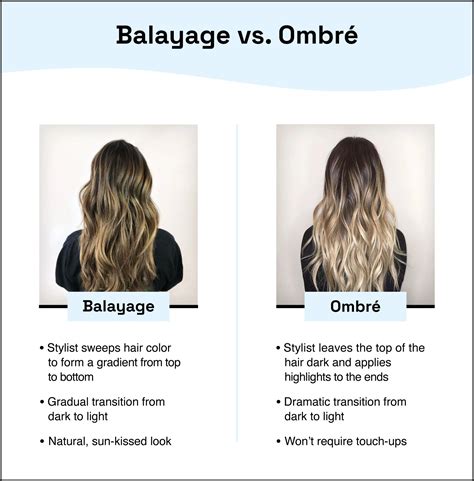Introduction

For fashion-forward individuals, hair trends are ever-evolving, introducing an array of captivating techniques. Among the most sought-after are ombre and balayage, two alluring coloring methods that elevate natural hair tones with captivating transitions. While often used interchangeably, these two techniques possess distinct differences that cater to the unique preferences and hair goals of each individual.
1. Definition
1.1 Ombre
Ombre is a French term that translates to “shadow.” It refers to a hair coloring technique that creates a gradual transition from dark roots to lighter ends. The result is a subtle fade that resembles the natural lightening of hair exposed to the sun.
1.2 Balayage
Balayage is a French technique that means “to sweep.” Unlike ombre, balayage involves hand-painting color onto the hair, creating free-form, soft transitions from root to tip. This method allows for a more customized and artistic approach, resulting in a sun-kissed, dimensional look.
2. Application
2.1 Ombre
Ombre is typically applied using a traditional hair dye or bleach. It requires a precision application to create the desired fade, which can be achieved using various techniques such as teasing the hair, using a comb, or freehand painting.
2.2 Balayage
Balayage, on the other hand, involves a more freehand approach. The hair is sectioned, and the color is applied with a brush or a balayage board. The stylist sweeps the color onto the hair, creating a soft, natural transition.
3. Transition
3.1 Ombre
Ombre creates a bolder contrast between the roots and the ends, with a more defined transition line. The fade can be subtle or dramatic, depending on the desired effect.
3.2 Balayage
Balayage results in a more seamless transition, with the color blending more subtly into the natural hair. The result is a sun-kissed, dimensional look, often described as “lived-in.”
4. Maintenance
4.1 Ombre
Ombre generally requires more frequent touch-ups than balayage, as the roots grow out more noticeably. Regular trims are also recommended to maintain the desired shape and avoid split ends.
4.2 Balayage
Balayage requires less frequent touch-ups, as the softer transition and the blended roots make regrowth less apparent. Trims are still recommended to maintain hair health and prevent breakage.
5. Suitability
5.1 Ombre
Ombre is a versatile technique that can be customized to suit various hair lengths, textures, and skin tones. It works particularly well on longer hair, where the gradual transition can be more pronounced.
5.2 Balayage
Balayage is also suitable for a wide range of hair types, but it is often preferred for those with medium to long hair. It is particularly effective in creating a sun-kissed, natural-looking effect on lighter hair tones.
Conclusion
Ombre and balayage are both captivating coloring techniques that offer distinct aesthetic effects. Ombre creates a bold, graduated transition, while balayage results in a softer, more natural-looking blend. The choice between the two ultimately depends on the desired look, hair type, and maintenance preferences. By understanding the key differences between ombre and balayage, individuals can make an informed decision that aligns with their individual hair goals and fashion aspirations.
